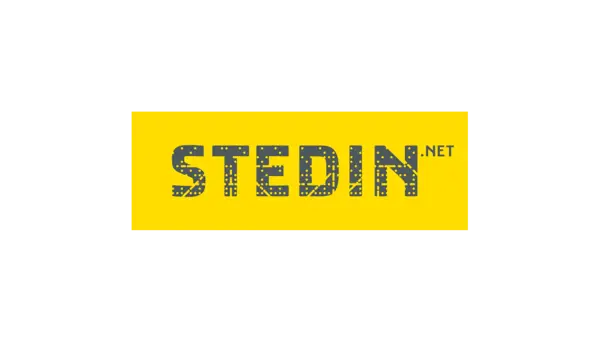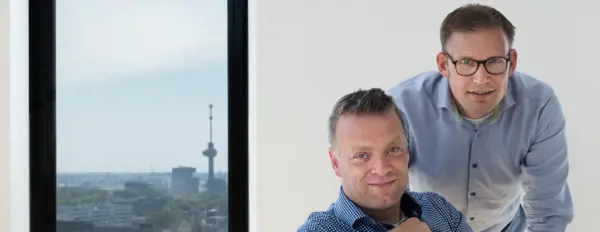Successful introduction of e-invoicing at Stedin: 'Start small and just do it!'
Network operator Stedin, mainly active in the conurbation of the Netherlands, is pioneering electronic invoicing via the open network. Why this pioneering role? And how did the electricity and gas distributor manage it? Project leader Michel Veeken and invoicing expert Niels Doms explain.

Michel Veeken, multi-channel billing project leader at grid operator Stedin, can still remember it well: how, as a relative newcomer to this world, he sat with a colleague at the Invoice Congress in early 2015, listening with open mouths to the inspiring presentations by specialists in electronic invoicing. A year later, April 2016, he himself was one of the speakers.
That says something about the acceptance of e-invoicing over the open network in the Netherlands, but perhaps even more about Stedin's energetic approach.
When this company, responsible for the transmission of electricity and gas, mainly in the Randstad region, started its implementation in early 2016, it was still sending around 90 per cent of its invoices by regular mail. By mid-2017, this percentage
halved. Another 45 per cent of over 40,000 connections for wholesale customers receive invoices digitally, as PDF files. The remaining 10 per cent receive electronic invoices.
This success did not go unnoticed. At the Factuurcongres 2016, via a webinar, for municipalities, in a magazine for the central government: everywhere, Veeken and Doms, as specialists from the finance department co-responsible for this project, have now told their story. The other grid managers - Stedin, together with Liander and Enexis, is one of the big three - regularly curiously peek around the corner.
Proud and still full of enthusiasm, they talk about their approach. How, through trial and error, they got numerous customers to 'switch over'. And about the benefits, challenges and plans for the future.
Too comprehensive
At Stedin, Veeken and Doms were not the first to sink their teeth into e-invoicing. There was also an initiative for 2015. Invoice sending, reminders, dunning, debtor balances, pending invoices: everything would be included. The initiative foundered. Partly because Stedin itself changed the organisation internally, and partly because the project turned out to be too big. 'All sorts of things were linked to it, it was too comprehensive,' says Veeken.
From the newly established financial shared service centre, the thread was picked up. Veeken and Doms took charge of this project - called multi-channel invoicing. With a clear message: don't go straight for the ultimate solution, start small and talk to a number of large customers first. See what they want. Veekens: 'We started working from the outside in.'
Customers' needs varied widely. Doms: 'Some said, "We are quite happy with a pdf file already."' That was an interesting insight for us. However, we did often have to explain the difference between a digital and electronic invoice. For us, an electronic invoice is a UBL/XML file that you send automatically and the recipient can process automatically, i.e. without any manual action.'
There was limited interest in electronic invoicing. And customers who did want this had the necessary requirements. Doms: 'Some sometimes mistakenly thought that we could only send electronic invoices via their own provider. Others wanted to determine exactly what should appear on the invoice. Requirements that Stedin could never meet for all wholesale customers individually.
 Niels Doms (l) en Michel Veeken (r)
Niels Doms (l) en Michel Veeken (r)
Better affordability
The grid operator persevered anyway. By first serving the many customers who wanted the invoice as a pdf, a relatively simple step, Stedin realised the first profit. It didn't stop there. Electronic invoicing, the second step, was also given the green light. 'Logical,' Veeken believes. The advantages are obvious. You work much more sustainably - we are a sustainable organisation -, you have lower handling costs, better assurance, more insight into the status of processing and affordability increases'.
'Quite right,' Doms adds. 'Customers pay better on electronic invoices.
For the simple reason that they put in the system that the invoice must be paid before the due date. Besides: if there is a dispute, you are more likely to reach a settlement. If something is wrong, the customer detects it sooner. And - last but not least: the new procurement law that stipulated that the central government would only accept e-invoices from new suppliers from January 1st this year was a big stick'.
Stedin started with a modest pilot project, with just 10 partners, including a few customers, a municipality (Zoetermeer), a software company, an accounting firm and 100 electronic invoices per month. These invoices also contain all information on consumption, connection values and other technical data. These data are in the so-called Energie eFactuur, the standard for electronic invoicing by parties in the energy sector for their customers.
Furthermore, it was clear to the grid operator that invoices had to be sent via Simplerinvoicing, the open e-invoicing network of European e-invoicing providers and financial software vendors that connects ERP, accounting and e-invoicing software.
As provider, Stedin chose the relatively small eConnect. This provider, also called billing service provider, forwards Stedin's electronic invoice to the customer via the Simplerinvoicing network or, in some cases, directly to the accounting software connected to econnect. Doms: 'We chose econnect because, like us, they believe in the power of the open network. That is not evident with all providers.'

Milestone
April 2016 marked the start of the pilot. It lasted until June, exactly three billing cycles. In the first month, there were some growing pains. Doms: 'Some customers were insufficiently aware of the possibilities of Simplerinvoicing, others turned out not even to be connected to this network because their provider had forgotten.' But a lot of things went well too.
The 'landing' of the first e-invoice with a customer was a memorable moment for Veeken, Doms and the other colleagues involved in the project. 'Yes, it's in the e-invoice queue, we were told,' says Veeken. 'For that customer business as usual: one-to-one, many companies have been sending each other electronic invoices for years. But for us, this was a real milestone.'
The second cycle already went much better. By the third, most of the problems had been solved. For the project team, in consultation with the account managers, there was reason to see which other customers might be eligible for electronic invoicing. One of these was KPN, also the largest with several thousand invoices per month.
KPN was also keen. Doms: 'They were enthusiastic, partly because the electronic invoice makes administration cheaper and more efficient for them. After a two-month pilot, KPN recently joined the Simplerinvoicing network and Stedin can send all invoices to the telecom and ICT company electronically. KPN will now look at whether the other energy suppliers and grid operators can invoice the telecom and ICT company electronically in the same way.
Incidentally, finding more customers who wanted to switch was not easy, Veeken adds. The national government and other public authorities - provinces, municipalities, water management authorities - were not eager either, despite the fact that by then it had already been widely decided that these parties would act as catalysts for e-invoicing in the Netherlands.
Stedin now invoices just under 10 per cent of all invoices electronically. The two gentlemen assume that this percentage will increase in the coming months
will increase even further, partly due to the requirement for central government suppliers to invoice electronically for all new contracts concluded after 1 January 2017. Veeken: 'That will push many organisations over the finish line.'
To give that flow itself an extra boost, Stedin plans to modify its website so that customers can switch to e-invoicing themselves via their portal. For a company with thousands of customers, this is essential. Doms: 'We want to put as little energy into this as possible. During the pilot, we worked very intensively with the participants. But it is impossible for us to do that with all customers.'
Just do it!
Do the gentlemen have any advice for companies and other organisations that also want to switch to e-invoicing? 'Just do it,' Veeken advises. 'That sounds rather easy. But what we mean by that: by just getting the theory from the internet, you won't make it. Only when you do it will you really start to understand it, you have to go through that. Start small, so it stays manageable. We ourselves are also very attached to an open network. We don't believe in endless one-to-one connections with customers. That only makes it unnecessarily complicated and expensive.'
With regard to the latter, Doms does have a request to the Interprovincial Consultation, the Association of Netherlands Municipalities, the Union of Water Boards and the umbrella organisations of all other local government organisations: just like the national government, opt for the Simplerinvoicing network. Doms: 'I understand that they cannot impose something like that like the national government. But the power of the open network should be used by as many organisations and government agencies as possible. For a company like Stedin, this makes a big difference - just take the many municipalities that are customers of ours.'
45 per cent of invoices digital, 45 per cent on paper, just under 10 per cent electronically: Stedin may have made considerable strides in a short time, but there is still much to be gained for the grid operator. Will there come a time when the company can send all its invoices electronically? 'You never completely get rid of postal and digital,' Veeken responds. 'But with the central government's obligation, things could go fast,' believes Doms. 'All the more so because of the enormous security awareness. To what extent is an invoice via e-mail still perceived as secure now and in the future? In that respect, too, a network like Simplerinvoicing offers a big improvement.' Source: CMweb
